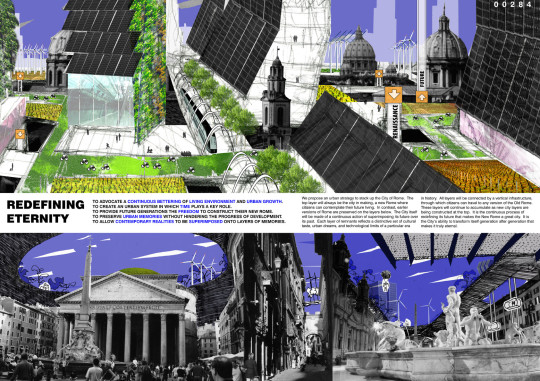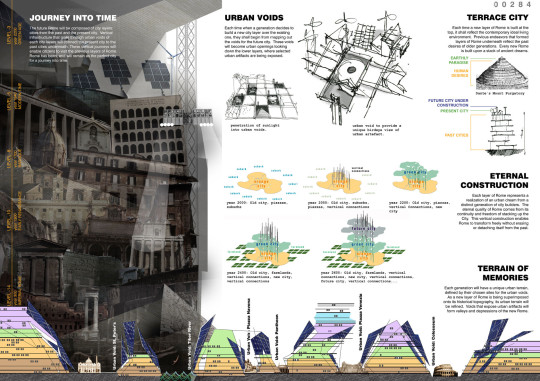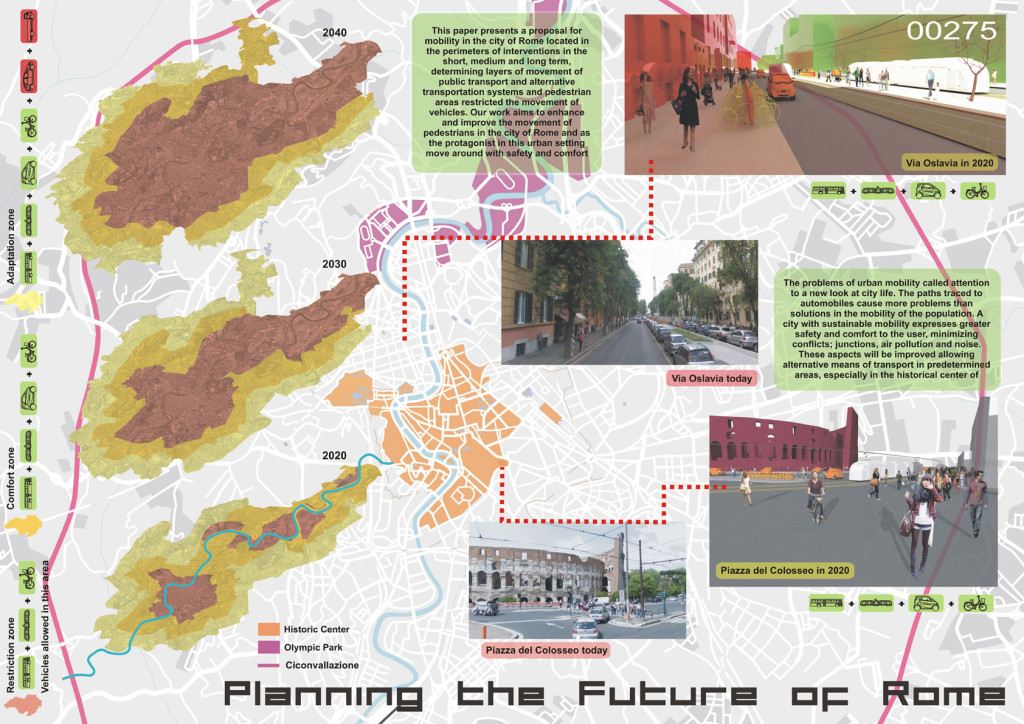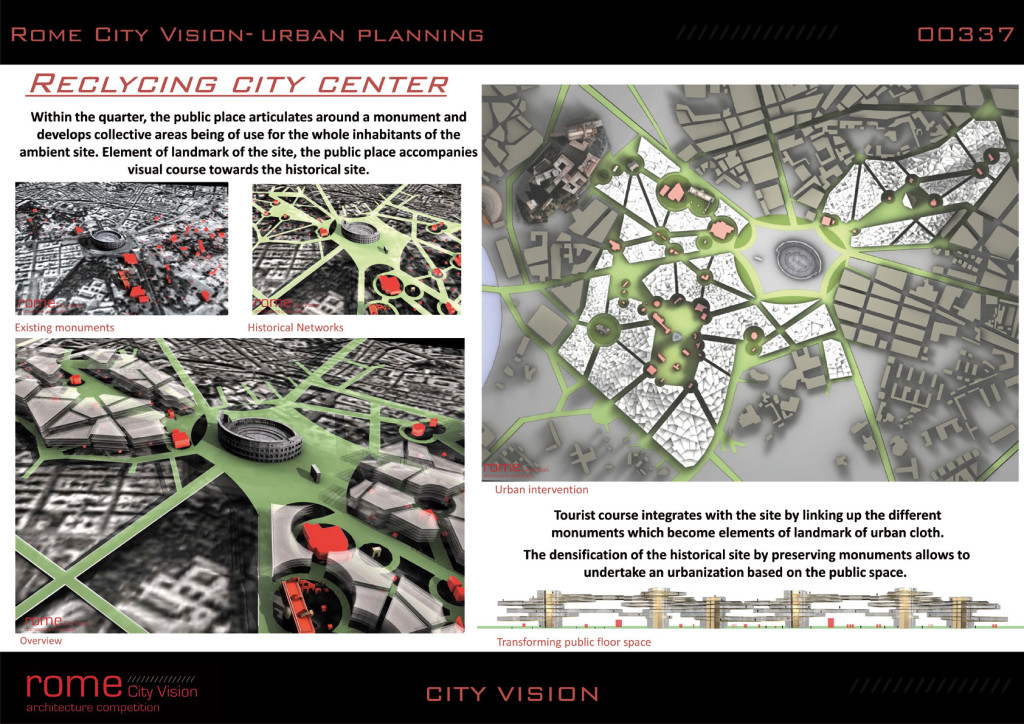Info:
Title: Redefining Eternity - Code: 00284Contest: Rome / 2010
By: Calvin Chiu / Angela Chan
Views: 3339 Likes: 1
Votes:
JUERGEN MAYER H. 0 FRANCESCO LIPARI1 FELIPE ESCUDERO1 FRANCESCO GATTI 7 MICHAEL CATON 12.0
Redefining Eternity


REDEFINING ETERNITY
It takes centuries to build a city and may take many generations for one to die. Everyone who has witnessed the fate ofVenicewould never want to see the same happens toRome. While modern planning continuously fails to offer a vision forRome’s future, the historical city centre has become a tourist wonderland where a fraction of contemporary Romans live in deteriorating living conditions. The rest of the population has little alternatives but to relocate themselves in the suburbs, where urban mobility is hindered by the poor public transit system. InCentral Rome, urban artifacts from the glorious past continue to dominate the contemporary landscape, posing great obstacles to any decent effort of urban transformation. Along the same line, ineffective planning strategies and an overall lack of vision on how to build a better city have ledRomeonto a path of gradual decline in the modern era.
On the other hand, theEternalCitycontinues to manifest great potentials and offer unique experience for generations of citizens to live along with the profound richness and complexity of an urban situation that took centuries to form. Apart from the richness of architectural styles, magnificent sequence of public spaces, and sophisticated use of the pedestrian scale, it is one’s experience of distorted time in the City that defines the unique identity ofRome. From a short walk in the historical city centre, one can experience the City’s complex relationship with time. It is by juxtaposing the past and present that one begins to make sense of the City. In today’sRome, the only missing piece in the spectrum of time is the future.
The project Redefining Eternity takes the issues and potentials ofRome to the extremes, and imagines an ideal City that will continue to grow in layers as human technology advances. The following objectives summarize the concepts of this proposal:
1) To advocate a continuous bettering of living environment and urban growth.
2) To create an urban system in which time plays a key role.
3) To provide future generations the freedom to construct their newRome.
4) To preserve memories of the City without hindering the progress of urban development.
5) To allow contemporary realities to be superimposed onto layers of preserved memories.
We propose an urban strategy to stack up the City ofRome. The top layer will always be the city in making, a newRomewhere citizens can contemplate their future living. In contrast, earlier versions ofRomeare preserved on the layers below. The City itself will be made of a continuous action of superimposing its future over its past. Each layer of remnants reflects a distinctive set of cultural taste, urban dreams, and technological limits of a particular era in history. All layers will be connected by a vertical infrastructure, through which citizens can travel to any layer of the old city. These layers will continue to accumulate asnew citylayers are being constructed at the top.
The main design features of this project include:
Terrace City
Each time a new layer of Romeis built at the top, it shall reflect the contemporary ideal living environment. Previous endeavors that formed layers of Romeunderneath reflect the past desires of older generations. Every new Romeis built upon a stack of ancient dreams.
Journey into Time
The futureRomewill be composed of city layers: cities from the past and the present city. Vertical infrastructure that goes through urban voids of each city layers will connect the present city to the past cities underneath. These vertical journeys will enable citizens to visit the previous layers ofRome. Romehas been, and will remain as the perfect city for a journey into time.
Urban Voids
Each time when a generation decides to build anew citylayer over the existing one, they shall begin from mapping out the voids for the future city. These voids will become urban openings looking down the lower layers, where selected urban artifacts are being exposed.
Terrain of Memories
Each generation will have a unique urban terrain, defined by their chosen sites for the urban voids. As a new layer ofRomeis being superimposed onto its historical topography, its urban terrain will be refined. Voids that expose urban artifacts will form valleys and depressions of the newRome.
Eternal Construction
Each layer ofRomerepresents a realization of an urban dream from a distinct generation of city builders. The eternal quality ofRomecomes from its continuity and freedom of stacking up the City. This vertical construction enablesRometo transform freely without erasing or detaching itself from the past.
A city vision demands much more than beautification of building facades, greening the age-old piazzas, or replacing damaged cobblestones. It requires imagination, courage, and desire: imagination to see beyond the immediate future, courage to challenge contemporary systems and policies, and a desire for change, a change that leads to better living conditions and a more sustainable lifestyle. Every piece of architectural masterpiece tells the story of their age, and also forms a part of the culture of the next generation. A great city should serve the current generation, and at the same time generates possibilities for making a better future. When a city loses the momentum to transform for the better, its decline is in sight. It is the continuous process of redefining its future that makes the New Rome a great city. It is the City’s ability to transform itself generation after generation that makes it truly eternal.






